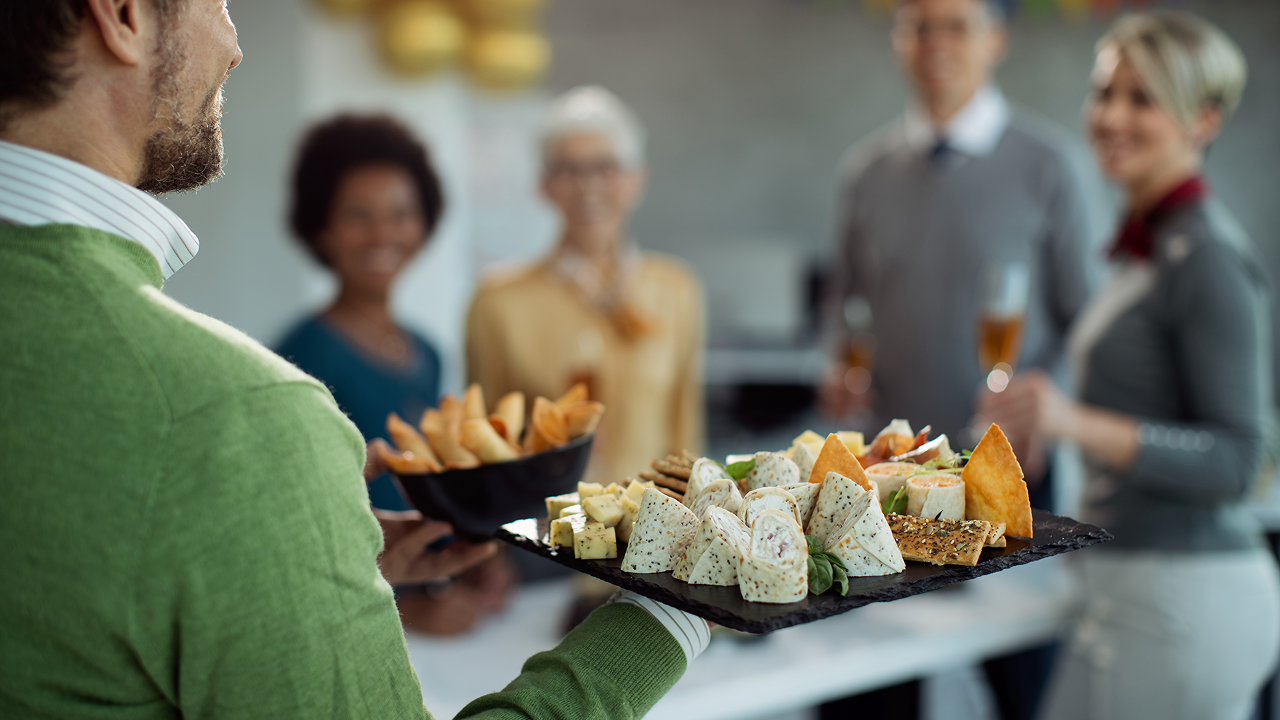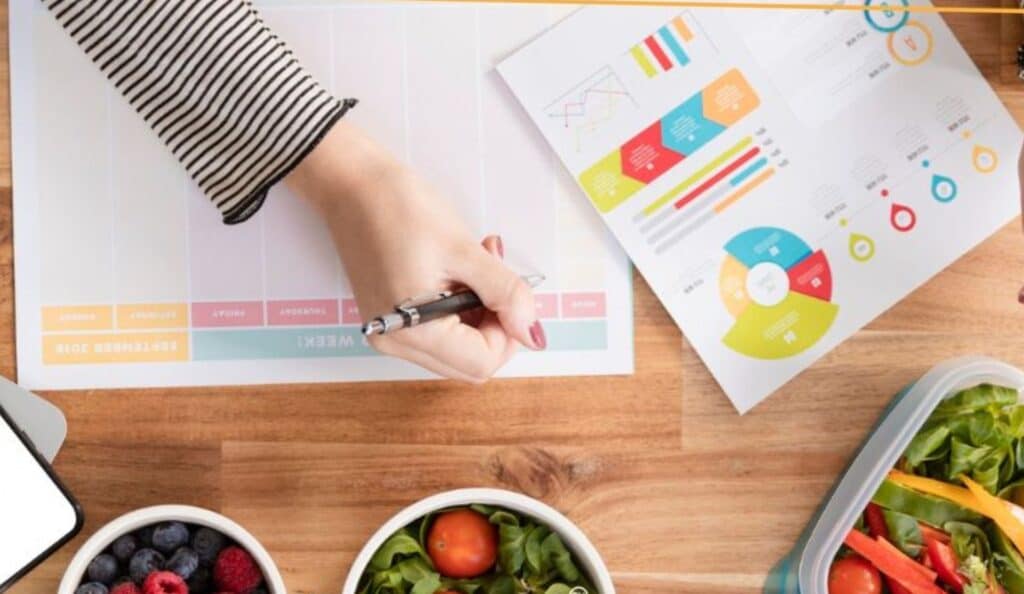
By Patricia Medrano March 19, 2025
Ordering food for a large group can be difficult since you must select various dishes and ensure that there is enough for everyone. You can’t buy too much food don’t buy too much food but have some extra This is challenging for smaller groups as well as larger groups of 100 or more, but also for those who would like vegetarian or vegan options.
When determining how much food to order, consider the group size, the variety of food, and guests’ preferences. Being together over food can make events more glamorous.
Controlling food portions is key for good catering and planning. Knowing how much food each person will eat helps with buying, storing, and preparing food, so you don’t run out or waste it. To find out how much food to serve, you need to do some simple math and understand how big a serving is.
Key Factors and Components

Every catering company’s cost is determined by a few key factors, including what type of service it is, how complex is the menu, the event size, and last but not least, the event site. Food makes a large part of the expenditure and prices also depend on the menus you choose. Labor and staffing is also another key factor. The salaries and wages of the chefs servers and clean-up crews also factor significantly into the catering overall budget. Little extras, such as rates for equipment rental, tolls, facility fees, and service fees, can also add to the overall price. Having a frank and open discussion with your catering service provider about all the costs and expenses will help you to get a good range from your service provider which is vital to keeping the catering experience within the budget.
Type of Event
What type of event determines what catering is required. A seated lunch requires less food than a formal dinner, for example, and guests at social events may eat less or more. Santopietro recommends one main dish, two sides, and drinks as a relatively good portion size. Formal dinners demand more food per person than buffets, whereas cocktail parties offer tiny snacks. Catering costs are also influenced by the event type. Weddings typically require a larger menu, a staffed team, and decor, all of which drive up the cost. Corporate events might go for a buffet station or drop-off catering, but private parties have more choices. You may need permits or extra equipment for outdoor events. Understanding these specifics assists in choosing the appropriate catering service and controlling costs.
Event And Venue Location
Prices for catering vary depending on the location and venue. Transport, traffic, parking, and worker pay all add costs. Towns could be more expensive due to labor costs and travel, and remote areas can be a bit more tricky. While in-house catering sounds less expensive, outside catering may also have additional charges. The number of guests and venue features and access also impact the total cost per person.
Event Length
\When arranging for catering, consider the length of the event. Shorter events might require less food; longer events might require more for seconds or thirds. For short events, you can get away with one serving, but longer events should have larger portions so that guests have enough.
Number of Guests
After that, determine how many guests will attend to calculate food portions. The number of people is also helpful for determining how much food to prepare. So, it’s preferable to confirm the guest count a couple of days prior to the event. Getting an accurate headcount is important for catering, as well as veggie and other dietary needs, as well as adjusting estimates based on the type of event, etc.
RSVP Invitation
For a well-run event, begin with a definitive guest list, send out RSVP (Respond, if it pleases you) invitations early, follow up with guests who haven’t replied, and add a few extra places for any unexpected guests who show up. For formal occasions, keep the buffer to a minimum but casual get-togethers can accommodate a larger number of extras.
Furthermore, when RSVPing, ask guests if they have any dietary needs like if they are vegetarian, vegan, gluten-free, nut-free, lactose-free, etc. Cooperate with the caterer to address those needs and provide a variety of options so that every guest can enjoy the meal.
Kind of Food
What kind of food is served affects how full people feel. Vegetarian meals generally require more food, such as a salad for vegetarian dinner, which may make it closer to five to six ounces per individual. Mexican or Italian cuisine is more filling, so people may not require as many sides. To ensure that there’s enough to go around, ask everyone to bring one main dish, then add on the side dishes. For instance, pulled pork gets served with cornbread, coleslaw, and dessert, or chips and dips with burritos. In calculating how much food to make, consider the menu items, average serving sizes, and number of guests. This is to determine the quantity of food and cooking equipment needed.
Estimate the Budget for Event Types
The type of event has a big impact on the food and drinks required. All-day events require more food and beverages than brief receptions, and if events will take place outdoors, particularly in hot weather, they may also require more drinks, especially water. Guests at casual gatherings often end up eating and drinking more over time. Budget and food portions; but the way to calculate how much food to serve depends on knowing the cost.
Calculating Catering Per Person

Determine The Amount You Want To Spend
You set your budget and you first decide how much to spend on catering and then how much you want to spend on different types of catering. You will have to compare quotes from various caterers to select such that provide good service and quality food. Put together a more diverse menu to accommodate varied tastes, and implementation control to save costs and cut waste.
Cost of Each Food Item
Meanwhile, if you want to plan an event, you need to know the cost of every food item as well as snack requirements. You have to know how many guests are going to attend to decide how much food to prepare. The same food will have different serving sizes based on the event. When calculating a main dish, budget for 6-8 ounces of protein per person, and for appetizers, plan on 4-5 pieces for each guest. As a rule of thumb side dishes should weigh about 4 ounces per person. For hors d’oeuvres, plan on 5 to 7 pieces per person, for one-hour events, and more for events that run longer. Desserts typically require one or two pieces per guest.
Guest Calculation
When planning for guests, think about how many people will come to set catering prices. Calculate appetizers for everyone and consider the timing before dinner to save on buffet costs. For catering, plan for 1.5 servings per guest and consider which dish is popular. Include vegetarian and vegan options in the main menu, and adjust the amount of meat and veggies as needed. For drinks, plan for about 2 gallons of non-alcoholic beverages per guest at the reception, with 1-2 cups of water and 3-4 other drinks. The time of the reception also plays a role in how much alcohol to serve; a common rule is to go with 50% wine, 20% beer, and 30% liquor. Be able to provide a good selection of drinks. Regarding desserts, eight hosts should be provided with 1.5 cupcakes or 3 cookies for each guest, plus 1 slice of cake.
Food Cost
To determine food quantities for the event, keep in mind how many guests there are so that waste can be prevented. Use proper equipment to estimate. After the menus are finalized, make a full list of ingredients and the expense. Identify vendors for specialty ingredients. Fixed meals make it easy to calculate; each guest will eat four to six ounces of meat, two vegetables, an appetizer, and a dessert. Goal food costs approximately 30% of the cost, but looking for 24-28% is more profitable. Estimate food cost per person for hors d’oeuvres, buffets, plated dinners, and table.
Beverages, Drinks, and Bar Calculation
For drinks at events, include both alcoholic and non-alcoholic options. Estimate 1.5 non-alcoholic drinks per person per hour, like water, soda, and juices. For alcoholic drinks, serve 1 to 2 drinks per person per hour, with a mix of beer, wine, and spirits for different tastes. Bars can be costly, sometimes 2-3 times the cost of food catering. Clients can buy their own alcohol and hire a licensed bartender if allowed. It’s suggested to plan for one drink per hour per person, with 35% beer, 30% wine, and 35% liquor. A keg of beer serves about 140 to 165 12 oz drinks, a 0.75-liter bottle of wine serves five 5 oz glasses, and a 1.75-liter bottle of liquor serves 40 1.5 oz drinks.
Waste Minimization
Good planning can help reduce waste by getting a precise guest count, using a catering calculator for food amounts, talking to the caterer about portion sizes, providing a balanced menu with enough variety, and planning for leftovers by sending extras home with guests or donating them to local shelters.
Service Style Variation
Food is usually charged based on how many guests you have and what kind of experience you want to bring them. Sit-down dinners take more staff and better service; buffets tend to be less expensive. The cost may also increase with full-service staff. The venue also contributes to catering costs, as cities see higher costs linked to traffic and parking fees. Unusual or off-the-beaten-path venues could have better rates and outside caterers may demand additional kitchen fees.
Partnering With The Right Catering Parties
Partnering with the right catering provider is critical to staying within budget while providing what guests want. Online calculators and spreadsheets are good tools for figuring out the price to cater per person.
Conclusion
Effective catering requires planning, accurate guest counts, and menu consideration. Portion control and dietary preferences to budgeting and type of event, every detail matters to ensure that there is enough food for all without excess.
Being aware of these factors allows one to manage costs, accommodate guests’ needs, and ensure a memorable experience. Regardless of the size or nature of your event, catering can make it seamless, enjoyable, and satisfying for all involved.